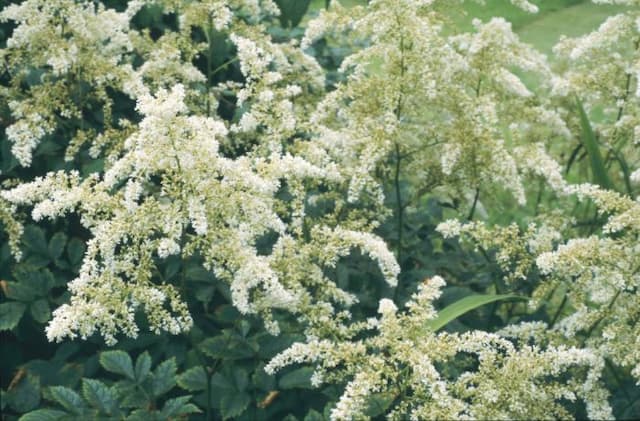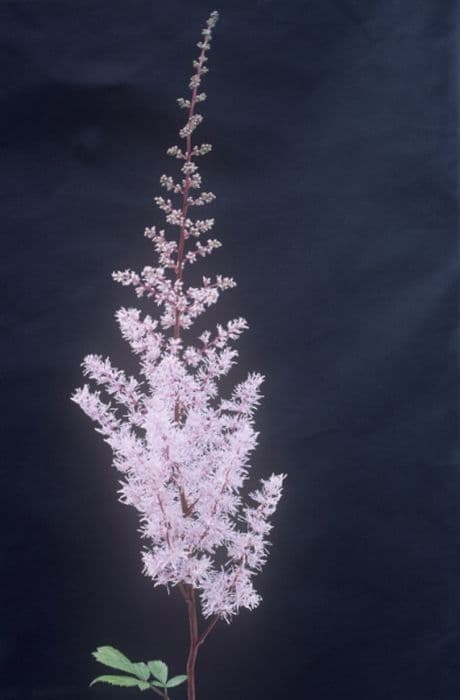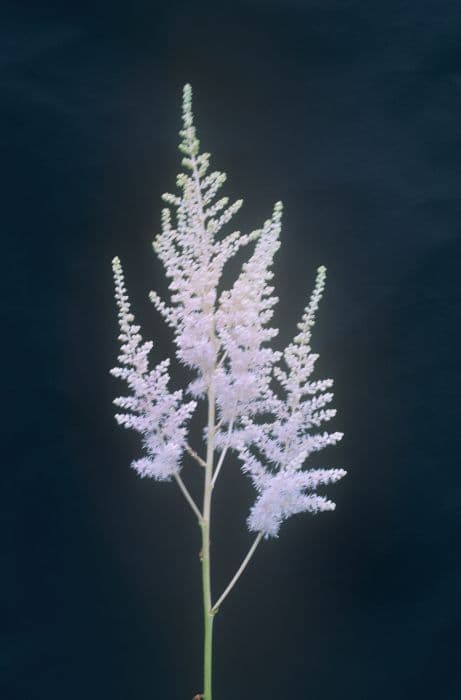Mossy Saxifrage Saxifraga 'Cumulus' (7)

ABOUT
Saxifraga 'Cumulus', also known as the Mossy Saxifrage or Rockfoil, is a charming, low-growing perennial plant that is popular for its decorative and dense mat-forming habit. Its foliage consists of small, rounded leaves that are typically bright green and moss-like in texture, hence the moniker "mossy". Throughout the growing season, these leaves create an attractive, cushioned mound that serves as a lush backdrop for the dainty flowers it produces. The flowers of Saxifraga 'Cumulus' are quite a sight to behold, often appearing in late spring or early summer. They are star-shaped and held aloft on slender, wiry stems, hovering like a delicate cloud above the dense foliage below. The petals are usually white, with hints of pink or red at their bases, which adds a splash of subtle color and contrast to the green carpet of leaves. The blossoms are arranged in loose panicles, and each individual bloom is small and delicate, creating a light, airy effect reminiscent of a cumulus cloud. This variety of Mossy Saxifrage is appreciated not only for its ground-covering ability but also for its ornamental value, thanks to its intricate floral display and the texture of its foliage. It is frequently utilized in rock gardens, alpine collections, or as edging along paths, where its low and spreading form is put to good use. The overall appearance of Saxifraga 'Cumulus' is one of delicate beauty and a fine, intricate texture that can soften and enhance the visual appeal of garden landscapes.
About this plant
 Names
NamesFamily
Saxifragaceae
Synonyms
Mossy Saxifrage, Cushion Saxifrage, Rockfoil
Common names
Saxifraga 'Cumulus'
 Toxicity
ToxicityTo humans
The Saxifrage, specifically the variety 'Cumulus', is generally considered non-toxic to humans. There are no common symptoms of poisoning associated with this plant because it is not known to be poisonous.
To pets
The Saxifrage, specifically the variety 'Cumulus', is not known to be toxic to pets. Therefore, if pets ingest parts of this plant, they are unlikely to experience symptoms of poisoning or face any significant health consequences.
 Characteristics
CharacteristicsLife cycle
Perennials
Foliage type
Evergreen
Color of leaves
Green
Flower color
White
Height
0.5 feet (15 cm)
Spread
1 feet (30 cm)
Plant type
Herb
Hardiness zones
5
Native area
Europe
Benefits
 General Benefits
General Benefits- Easy to Grow: Saxifraga 'Cumulus' requires minimal care, making it suitable for novice gardeners.
- Drought Tolerant: Once established, it is quite tolerant to dry conditions, requiring less frequent watering.
- Ground Cover: Its low-growing nature helps to cover bare spots in gardens, suppressing weeds.
- Ornamental Appeal: The plant has attractive foliage and blooms that enhance the beauty of garden spaces.
- Rock Gardens: It is an ideal plant for rock gardens, fitting well into crevices and over stones.
- Seasonal Interest: Saxifraga 'Cumulus' offers a long season of interest with its flowers and sometimes evergreen leaves.
- Pollinators: The flowers attract pollinating insects, which is beneficial for the garden ecosystem.
 Medical Properties
Medical PropertiesThis plant is not used for medical purposes.
 Air-purifying Qualities
Air-purifying QualitiesThis plant is not specifically known for air purifying qualities.
 Other Uses
Other Uses- Saxifraga 'Cumulus', commonly known as Mossy Saxifrage, can be utilized as a decorative element in crafting, such as embellishing picture frames or creating texture in mixed media art due to its moss-like foliage.
- These plants are often used in fairy gardens or miniature landscapes as they can mimic larger plant types in reduced scale settings, creating a whimsical effect.
- Due to its compact growth habit, Mossy Saxifrage can be planted between steppingstones to soften the look of a garden path and provide a green foil to the hardscaping.
- They serve as a natural refrigerator decoration, kept in small pots, to bring a touch of greenery to a typically plant-free environment when proper light conditions are met.
- Saxifraga 'Cumulus' can be grown in shallow bowls or dishes alongside other alpines for tabletop displays or in small-scale alpine garden presentations.
- Mossy Saxifrage can be placed in hanging baskets to create a curtain of foliage, often serving as a living backdrop on balconies and patios.
- This plant can also be used to accentuate the bases of bonsai trees, complementing the aesthetic with its rosette-forming nature, and offering a contrasting texture at the foot of the miniature tree.
- It can be used in educational settings to demonstrate ground-cover growth patterns or as an example of alpine plant adaptations, engaging students in botany studies.
- When planted in transparent containers, the root structure of Mossy Saxifrage can become a point of interest, turning the attention to the often ignored underground parts of plants.
- As a living mulch, it can cover soil in potted plants, helping to retain moisture and suppress weeds, all the while adding ornamental value to the container.
Interesting Facts
 Feng Shui
Feng ShuiThe Mossy Saxifrage is not used in Feng Shui practice.
 Zodiac Sign Compitability
Zodiac Sign CompitabilityThe Mossy Saxifrage is not used in astrology practice.
 Plant Symbolism
Plant Symbolism- Perseverance: Saxifrages, also known as rockfoils, symbolize an unwavering spirit due to their ability to grow in rocky terrains and cracks where other plants might not survive.
- Tenacity: The plant's name 'Saxifraga' comes from the Latin for "stone-breaker," highlighting its strength and tenacity as it is often found wedged in the crevices of stones, seemingly breaking them apart.
- Protection: In some traditions, saxifrages are associated with protection because of their dense growth which can seem like a protective barrier.
- Enduring Love: Due to its hardy nature, saxifrages are sometimes seen as a symbol of lasting or enduring love that can withstand adversities.
- New Opportunities: By growing in challenging places, rockfoils can represent the idea of new beginnings or opportunities arising from seemingly inhospitable situations.
 Water
WaterMossy Saxifrages should be watered thoroughly, allowing the soil to become moderately dry between waterings. Typically, this plant requires watering roughly once a week, but this can vary with environmental conditions. In hotter or drier climates, it might need watering twice a week, while during cooler months, less frequent watering is necessary. When you do water, apply enough so that water runs through the drainage holes, generally using about 16-32 ounces, depending on pot size and soil dryness.
 Light
LightMossy Saxifrages prefer bright, indirect light, benefiting from a few hours of morning sun followed by partial shade. They thrive under dappled sunlight, making them ideal for east-facing locations where they are protected from the intense afternoon sun. Avoid exposure to harsh, direct sunlight, especially during the hot summer months.
 Temperature
TemperatureMossy Saxifrages flourish in cooler temperatures ranging between 60 to 75 degrees Fahrenheit. They can tolerate temperatures as low as 20 degrees Fahrenheit, which allows them to withstand some frost. The ideal growing conditions prevent the plant from being exposed to temperatures above 80 degrees Fahrenheit, as this could stress the plant.
 Pruning
PruningPruning Mossy Saxifrages helps maintain their shape and encourages denser growth. It's best to prune them lightly after flowering to remove spent blossoms and any leggy or dead growth. This usually occurs once a year in late spring or early summer. Avoid heavy pruning, as the plant may not recover well.
 Cleaning
CleaningAs needed
 Soil
SoilSaxifraga, commonly known as Rockfoil, thrives best in a well-draining, humus-rich soil mix with coarse sand or perlite for aeration. The pH should be slightly acidic to neutral, ideally ranging from 5.5 to 7.0. A mix of two parts peat, one part loam, and one part sharp sand or perlite can create an ideal growing medium.
 Repotting
RepottingRockfoils should be repotted every 2 to 3 years to refresh the soil and accommodate root growth. It's important not to over-pot as they prefer a cozy root space.
 Humidity & Misting
Humidity & MistingRockfoils prefer moderate humidity levels. While they can tolerate some dry air, it's beneficial to maintain humidity around 50% for optimal growth.
 Suitable locations
Suitable locationsIndoor
Place Rockfoil in bright, indirect light.
Outdoor
Plant Rockfoil in partial shade; protect from hot sun.
Hardiness zone
6-8 USDA
 Life cycle
Life cycleThe life cycle of the Saxifraga 'Cumulus', also known as the Rockfoil, begins with seed germination in a well-drained, moist substrate in a cool environment. Once the seedlings emerge, they develop into rosettes of leaves, progressively growing and establishing a strong root system. The plant enters a vegetative stage where it produces dense tufts of small, green leaves and starts to spread through stolons. During the flowering stage, Saxifraga 'Cumulus' produces clusters of delicate, small white flowers held above the foliage on thin, wiry stems usually in the late spring to early summer. After pollination and fertilization, the plant produces seed capsules that release seeds, completing the sexual reproduction cycle. Aside from sexual reproduction, this perennial can also propagate vegetatively through division of the clumps in the spring or autumn, ensuring the continuation of the plant beyond one growing season.
 Propogation
PropogationPropogation time
Spring-Early Summer
Propogation: Saxifraga 'Cumulus', commonly known as Mossy Saxifrage, is typically propagated by division, a method best carried out in spring just as the plant begins to show new growth. To propagate by division, carefully dig up the plant, ensuring you keep a generous amount of soil around the roots. Gently tease the plant into several smaller clumps, each with a decent root system and several shoots. Replant the divisions immediately at the same depth they were originally growing, spacing them about 6 to 9 inches (approximately 15 to 23 centimeters) apart, to allow for ample growth. Water the newly planted divisions thoroughly to help establish them in their new locations.









